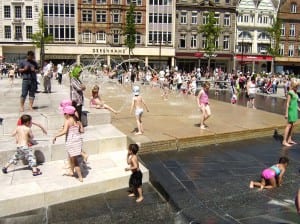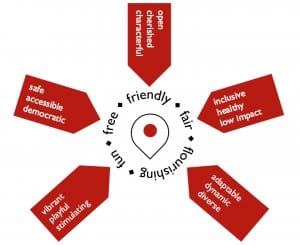The Big Question on…local environment
By ucyow3c, on 28 April 2015
Is recession an opportunity for local places?
Place quality: A 2020 call to action
2020 is just five years away, or to put it another way, in 2020 we will be electing our next parliament. A new post-austerity path towards place quality could empower local government, the development industry, our built environment professions and the diverse local communities of interest to rally behind such a vision.
Impacts of place are profound and reverberate throughout the lives of citizens. It follows then that a shared local concern for and engagement in the processes of management and change should extend to all local communities as a universal civilising force. Our local environments must meet basic human needs, such as a decent and affordable home, a sense of community and belonging, and freedom of movement and safety. This requires working collectively from the largest city-wide scale down to the individual street or space to ensure that places enrich our lives and encourage a healthy attachment to localities. It implies qualities of place that I have defined elsewhere in terms of five ‘F’s; places that are Friendly, Fair, Flourishing, Fun and Free
Five immediate priorities
Unfortunately, an unintended consequence of the austerity years has been that services that focus on place within local government and elsewhere have been hit first and hardest by cuts. In part this reflects the discretionary nature of many such activities. It also reflects the fact that the impact of cuts in these services is rarely immediate, and sometimes won’t be felt for many years. If they continue, however, problems multiply, environments deteriorate, and local government and other public agencies become de-skilled and de-sensitised to the profound importance of place.
Whatever our political thinking and whether we favour big or small government, the reality is that the public parts of our urban areas remain overwhelmingly in public ownership and a largely governmental responsibility. Consequently the spiralling costs of disengagement will eventually catch up with us, and when they do they will fall squarely on the public purse.
Reflecting this perilous state of affairs national government should:
Empower local government and other place focussed public agencies to more consistently prioritise place quality by:
- Reviewing the role and responsibilities of the Housing and Communities Agency (HCA) and Local Economic Partnerships (LEPs) in delivering place quality, and issuing appropriate advice to restate and support this important dimension of their work
- Issuing a model Charter of public space rights and responsibilities for adoption and use by local authorities when negotiating the provision of new privately managed public spaces
- Getting firmly behind industry initiatives to reimagine street design and reprioritise highway land for ‘place’ as well as ‘movement’ functions, whilst removing national regulations that lead to formulaic design solutions
- Issuing guidance to parks and recreation departments on the imperative for the sustainable provision, management and quality of green open space and play provision
- Encouraging the reuse of vacant residential properties by raising the ‘Empty Homes Premium’ to up to 300% of the normal Council Tax and requiring local authorities to collect it, and by extending the ‘Community Right to Reclaim Land’ to the temporary use of private derelict land.
Support a new strong drive for positive planning as the heart of these efforts by:
- Allowing the current system of neighbourhood and local planning and plan-making to bed down and mature by avoiding further significant legislative changes, but working with industry partners to establish expectations on the preparation and use of proactive planning tools such as flexible urban design frameworks and design codes
- Paving the way for re-building planning and development services following the largest cuts (of 43%) experienced by any local government service, by facilitating a move towards proactive planning, granting the freedom to local authorities to set their own planning fees and moving towards a 100% retention of any uplift in local business rates
- Strengthening guidance in the National Planning Policy framework (NPPF) to, first, make formal design review compulsory for all major developments and recommended for locally significant minor developments, and second, to give formal recognition to locally listed heritage assets and encouragement to the preparation and adoption of local lists.
Whist national government can and should establish the broad national goals and aspirations for place quality, much of its role is in empowering others to deliver. Key amongst these parties will be local government whose range of place based services and influence locally is unparalleled. Reflecting this position, and in concert with relevant local stakeholders, local government should:
Fully understand and embrace their central position in the delivery of place quality by:
- Adopting a high level local authority wide ‘Architecture, urban design and place policy’ in order to establish cross-cutting place quality ambitions through the range of public services – planning, highways, housing, parks and recreation, street scene, estate management – and in any capital building projects; this might have the five ‘F’s at its heart
- Appointing in-house dedicated urban design and conservation expertise proportionate to the size and complexity of the local authority
- Establishing a programme of regular design training for councillors that is compulsory for those on planning committees or with oversight of highways or housing responsibilities
Centrally engage local communities and local businesses in the processes of shaping and re-shaping local places in order that they become full partners in the pursuit of place quality by:
- Establishing a voluntary Citizen Place Board to consult and advise on all place based priorities and to help hold local place related services to account
- Making available to the community, private organisations or other public bodies any prominent underutilised land or sites for publically beneficial temporary (meanwhile) uses
- Putting in place awareness raising and direct technical assistance to encourage less advantaged communities to engage with their local environment and in the neighbourhood planning process
- Instigating a citizens award scheme for local architecture, landscape, conservation and urban design projects
- Facilitating the establishment of Business Improvement Districts (BIDs) for all town centres, local high streets, and shopping parades
Become more proactive in pursuing the direct enhancement of place quality in new and existing urban environments, by
- Putting in place arrangements for the systematic design review of all major developments and significant minor developments
- Stabilising public funding to parks and recreational services whilst exploring innovative means to both supplement income for these critical public assets, and engage communities in their on-going management
- Reviewing and updating all local highway standards, guidance and adoption practices in accordance with Manual for Streets 1 and 2
- Regularly using the new General Powers of Competence to proactively protect and enhance locally important place based assets, facilities, and qualities, such as local pubs, post offices and green spaces.
Twenty ‘quick(ish) wins’ for 2020
In England 90% of us live in urban areas on just 10% of the land. As a consequence, we face a continuing challenge; how to shape our urban areas in a manner that ensures they are attractive places to live that offer the very best life chances and experiences, whilst encouraging our citizens to value existing urban areas and so help reduce pressure for development in unsustainable locations.
This pursuit of local place quality is a long-term goal, but with political support there are many things that can be done to deliver profound place quality benefits. Twenty concrete proposals are set out under the five national priorities above, many of which represent relatively quick wins for government and local government alike. Locally and nationally such action will be popular as they will quickly herald ready signs of tangible and highly visible positive change. With only modest cost and the help of key organisations and individuals such as those that have come together to form the Place Alliance, it should be possible to make real and substantial progress on each of the five priority areas by 2020 and through this means, together, re-capture the place quality agenda.
Professor Matthew Carmona, Bartlett School of Planning, UCL
UCL’s Big Questions sought contributions from academics around UCL to address the ‘big question’ facing the next UK government, and how research can provide an evidence base. It was devised by Clio Heslop (UCL Department of Science, Technology, Engineering and Public Policy) and Olivia Stevenson (UCL Public Policy), with the support of the Communications and Marketing team.
Have your say on the big questions by tweeting using #UCLGE2015, by leaving a blog comment, or by contacting the organisers.
Please join us on 27 May for the UCL’s Big Question Time event.
 Close
Close




